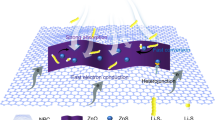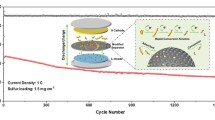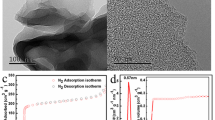Abstract
Increasing the amount of the nitrogen dopant, especially pyridinic-N species, in carbonaceous materials has been shown to significantly enhance the performance of lithium-sulfur (Li-S) batteries. Despite the positive impact of N do** on carbonaceous materials, the practical realisation of a high N dopant content of >5 at.% remains a significant challenge. Furthermore, to regulate the specific N species in carbonaceous materials is another hurdle. Herein, we obtained a three-dimensional honeycomb-like N-doped mesoporous carbon (PNMC) material with a high N dopant content of 8.82 at.% (pyridinic-N content, 3.49 at.%) by calcining calcium pantothenate under an Ar atmosphere after a phosphorisation process. It is believed that the P dopant contributes to the enhancement of not only the N content but also the polysulfide adsorption capability of the N dopant. As expected, the sulfur cathode comprising PNMC prepared at 800°C (S/PNMC-800) exhibited superior electrochemical performance as confirmed by the discharge specific capacity of 556.7 mA h g−1 observed after 300 cycles at 1 C. This study proposes a facile regulation technique to dope pyridinic-N species in carbonaceous materials, which may trigger the future inventive development of functional S hosts for use in Li-S batteries.

摘要
提高碳材料中氮的掺杂含量, 尤其是吡啶氮的含量, 已被证明可 以显著提升锂硫(Li-S)电池的性能. 尽管在碳材料中氮掺杂具有积极作 用, 但在实际操作中要实现>5 at.%的高氮掺杂含量仍非易事. 此外, 无 法调节碳材料中特定的氮种类也是研究中的一个难题. 在本文中, 我们 通过在氩气气氛下煅烧预先经过磷化处理的泛酸钙, 得到了一种三维 蜂窝状的氮(N)掺杂介孔碳(PNMC), 其N掺杂含量高达8.82 at.%(吡啶 N含量为3.49 at.%). 磷掺杂不仅有助于提高N掺杂量, 还有助于提升对 多硫化物的吸附能力. 实验证明, 在800°C下制备的PNMC组装的硫** 极(S/PNMC-800)表现出优异的电化学性能, 在1 C下经过300圈循环后 仍有556.7 mA h g−1放电比容量. 本工作提出了一种调控碳材料中吡啶 氮含量的简便方法, 为用于锂硫电池的多功能硫载体材料的开发提供 启发.
Similar content being viewed by others
References
Zhang H, Yang L, Zhang P, et al. MXene-derived TinO2n−1 quantum dots distributed on porous carbon nanosheets for stable and long-life Li-S batteries: Enhanced polysulfide mediation via defect engineering. Adv Mater, 2021, 33: 2008447
Yan C, Cheng XB, Tian Y, et al. Dual-layered film protected lithium metal anode to enable dendrite-free lithium deposition. Adv Mater, 2018, 30: 1707629
Cha E, Patel MD, Park J, et al. 2D MoS2 as an efficient protective layer for lithium metal anodes in high-performance Li-S batteries. Nat Nanotech, 2018, 13: 337–344
Bruce PG, Freunberger SA, Hardwick LJ, et al. Li-O2 and Li-S batteries with high energy storage. Nat Mater, 2012, 11: 19–29
Fu Y, Wu Z, Yuan Y, et al. Switchable encapsulation of polysulfides in the transition between sulfur and lithium sulfide. Nat Commun, 2020, 11: 845
Peng L, Wei Z, Wan C, et al. A fundamental look at electrocatalytic sulfur reduction reaction. Nat Catal, 2020, 3: 762–770
Shang C, Cao L, Yang M, et al. Freestanding Mo2C-decorating N-doped carbon nanofibers as 3D current collector for ultra-stable Li-S batteries. Energy Storage Mater, 2019, 18: 375–381
Ji X, Lee KT, Nazar LF. A highly ordered nanostructured carbon-sulphur cathode for lithium-sulphur batteries. Nat Mater, 2009, 8: 500–506
Manthiram A, Fu Y, Chung SH, et al. Rechargeable lithium-sulfur batteries. Chem Rev, 2014, 114: 11751–11787
Wu F, Zhao S, Chen L, et al. Metal-organic frameworks composites threaded on the CNT knitted separator for suppressing the shuttle effect of lithium sulfur batteries. Energy Storage Mater, 2018, 14: 383–391
Xu H, Jiang Q, Zhang B, et al. Integrating conductivity, immobility, and catalytic ability into high-N carbon/graphene sheets as an effective sulfur host. Adv Mater, 2020, 32: 1906357
Li Z, **ao Z, Wang S, et al. Engineered interfusion of hollow nitrogen-doped carbon nanospheres for improving electrochemical behavior and energy density of lithium-sulfur batteries. Adv Funct Mater, 2019, 29: 1902322
Pei F, An T, Zang J, et al. From hollow carbon spheres to N-doped hollow porous carbon bowls: Rational design of hollow carbon host for Li-S batteries. Adv Energy Mater, 2016, 6: 1502539
Yang D, Zhang C, Biendicho JJ, et al. ZnSe/N-doped carbon nanoreactor with multiple adsorption sites for stable lithium-sulfur batteries. ACS Nano, 2020, 14: 15492–15504
Zhang L, Wang Y, Niu Z, et al. Advanced nanostructured carbon-based materials for rechargeable lithium-sulfur batteries. Carbon, 2019, 141: 400–416
Zheng M, Chi Y, Hu Q, et al. Carbon nanotube-based materials for lithium-sulfur batteries. J Mater Chem A, 2019, 7: 17204–17241
Li H, Tao Y, Zhang C, et al. Dense graphene monolith for high volumetric energy density Li-S batteries. Adv Energy Mater, 2018, 8: 1703438
Li C, Yu J, Xue SL, et al. Wood-inspired multi-channel tubular graphene network for high-performance lithium-sulfur batteries. Carbon, 2018, 139: 522–530
Liu S, Zhao T, Tan X, et al. 3D pomegranate-like structures of porous carbon microspheres self-assembled by hollow thin-walled highly-graphitized nanoballs as sulfur immobilizers for Li-S batteries. Nano Energy, 2019, 63: 103894
** C, Zhang W, Zhuang Z, et al. Enhanced sulfide chemisorption using boron and oxygen dually doped multi-walled carbon nanotubes for advanced lithium-sulfur batteries. J Mater Chem A, 2017, 5: 632–640
Ren J, **a L, Zhou Y, et al. A reduced graphene oxide/nitrogen, phosphorus doped porous carbon hybrid framework as sulfur host for high performance lithium-sulfur batteries. Carbon, 2018, 140: 30–40
Sun F, Wang J, Chen H, et al. High efficiency immobilization of sulfur on nitrogen-enriched mesoporous carbons for Li-S batteries. ACS Appl Mater Interfaces, 2013, 5: 5630–5638
Kim M, Lee J, Jeon Y, et al. Phosphorus-doped graphene nanosheets anchored with cerium oxide nanocrystals as effective sulfur hosts for high performance lithium-sulfur batteries. Nanoscale, 2019, 11: 13758–13766
Wu F, Li J, Tian Y, et al. 3D coral-like nitrogen-sulfur co-doped carbon-sulfur composite for high performance lithium-sulfur batteries. Sci Rep, 2015, 5: 13340
Hou TZ, Chen X, Peng HJ, et al. Design principles for heteroatom-doped nanocarbon to achieve strong anchoring of polysulfides for lithium-sulfur batteries. Small, 2016, 12: 3283–3291
Song Z, Lu X, Hu Q, et al. Synergistic confining polysulfides by rational design a N/P co-doped carbon as sulfur host and functional interlayer for high-performance lithium-sulfur batteries. J Power Sources, 2019, 421: 23–31
Miao H, Li S, Wang Z, et al. Enhancing the pyridinic N content of nitrogen-doped graphene and improving its catalytic activity for oxygen reduction reaction. Int J Hydrogen Energy, 2017, 42: 28298–28308
Yuan H, Zhang W, Wang J, et al. Facilitation of sulfur evolution reaction by pyridinic nitrogen doped carbon nanoflakes for highly-stable lithium-sulfur batteries. Energy Storage Mater, 2018, 10: 1–9
Sun J, Wang L, Song R, et al. Enhancing pyridinic nitrogen level in graphene to promote electrocatalytic activity for oxygen reduction reaction. Nanotechnology, 2016, 27: 055404
**ao Z, Kong D, Song Q, et al. A facile Schiff base chemical approach: Towards molecular-scale engineering of N—C interface for high performance lithium-sulfur batteries. Nano Energy, 2018, 46: 365–371
Mo R, Rooney D, Sun K, et al. 3D nitrogen-doped graphene foam with encapsulated germanium/nitrogen-doped graphene yolk-shell nanoarchitecture for high-performance flexible Li-ion battery. Nat Commun, 2017, 8: 13949
Fechler N, Zussblatt NP, Rothe R, et al. Eutectic syntheses of graphitic carbon with high pyrazinic nitrogen content. Adv Mater, 2016, 28: 1287–1294
Kapteijn F, Moulijn JA, Matzner S, et al. The development of nitrogen functionality in model chars during gasification in CO2 and O2. Carbon, 1999, 37: 1143–1150
Kong L, Li BQ, Peng HJ, et al. Porphyrin-derived graphene-based nanosheets enabling strong polysulfide chemisorption and rapid kinetics in lithium-sulfur batteries. Adv Energy Mater, 2018, 8: 1800849
Wang M, Zhou X, Cai X, et al. Hierarchically porous, ultrathin N-doped carbon nanosheets embedded with highly dispersed cobalt nanoparticles as efficient sulfur host for stable lithium-sulfur batteries. J Energy Chem, 2020, 50: 106–114
Du L, Wu Q, Yang L, et al. Efficient synergism of electrocatalysis and physical confinement leading to durable high-power lithium-sulfur batteries. Nano Energy, 2019, 57: 34–40
Wang S, Zou K, Qian Y, et al. Insight to the synergistic effect of N-do** level and pore structure on improving the electrochemical performance of sulfur/N-doped porous carbon cathode for Li-S batteries. Carbon, 2019, 144: 745–755
**ao J, Wang H, Li X, et al. N-doped carbon nanotubes as cathode material in Li-S batteries. J Mater Sci-Mater Electron, 2015, 26: 7895–7900
Wang W, Shang L, Chang G, et al. Intrinsic carbon-defect-driven electrocatalytic reduction of carbon dioxide. Adv Mater, 2019, 31: 1808276
He B, Liu F, Yan S. Temperature-directed growth of highly pyridinic nitrogen doped, graphitized, ultra-hollow carbon frameworks as an efficient electrocatalyst for the oxygen reduction reaction. J Mater Chem A, 2017, 5: 18064–18070
Yang M, Hu X, Fang Z, et al. Bifunctional MOF-derived carbon photonic crystal architectures for advanced Zn-air and Li-S batteries: Highly exposed graphitic nitrogen matters. Adv Funct Mater, 2017, 27: 1701971
Zhang J, Huang M, ** B, et al. Systematic study of effect on enhancing specific capacity and electrochemical behaviors of lithium-sulfur batteries. Adv Energy Mater, 2018, 8: 1701330
Clark SJ, Segall MD, Pickard CJ, et al. First principles methods using CASTEP. Z für Kristallog-Cryst Mater, 2005, 220: 567–570
Perdew JP, Burke K, Ernzerhof M. Generalized gradient approximation made simple. Phys Rev Lett, 1996, 77: 3865–3868
Tkatchenko A, Scheffler M. Accurate molecular van der Waals interactions from ground-state electron density and free-atom reference data. Phys Rev Lett, 2009, 102: 073005
Wang L, Yang C, Dou S, et al. Nitrogen-doped hierarchically porous carbon networks: Synthesis and applications in lithium-ion battery, sodium-ion battery and zinc-air battery. Electrochim Acta, 2016, 219: 592–603
Wu H, Huang Y, Xu S, et al. Fabricating three-dimensional hierarchical porous N-doped graphene by a tunable assembly method for interlayer assisted lithium-sulfur batteries. Chem Eng J, 2017, 327: 855–867
Yang M, Wang L, Li M, et al. Structural stability and O2 dissociation on nitrogen-doped graphene with transition metal atoms embedded: A first-principles study. AIP Adv, 2015, 5: 067136
Bu S, Yao N, Hunter MA, et al. Design of two-dimensional carbon-nitride structures by tuning the nitrogen concentration. npj Comput Mater, 2020, 6: 128
Gu J, Du Z, Zhang C, et al. Pyridinic nitrogen-enriched carbon nanogears with thin teeth for superior lithium storage. Adv Energy Mater, 2016, 6: 1600917
Deng C, Wang Z, Wang S, et al. Inhibition of polysulfide diffusion in lithium-sulfur batteries: Mechanism and improvement strategies. J Mater Chem A, 2019, 7: 12381–12413
**e Y, Chen Y, Liu L, et al. Ultra-high pyridinic N-doped porous carbon monolith enabling high-capacity K-ion battery anodes for both half-cell and full-cell applications. Adv Mater, 2017, 29: 1702268
Ai W, Zhou W, Du Z, et al. Nitrogen and phosphorus codoped hierarchically porous carbon as an efficient sulfur host for Li-S batteries. Energy Storage Mater, 2017, 6: 112–118
Casanovas J, Ricart JM, Rubio J, et al. Origin of the large N 1s binding energy in X-ray photoelectron spectra of calcined carbonaceous materials. J Am Chem Soc, 1996, 118: 8071–8076
Wang J, Han WQ. A review of heteroatom doped materials for advanced lithium-sulfur batteries. Adv Funct Mater, 2022, 32: 2107166
Yao W, Zheng W, Xu J, et al. ZnS-SnS@NC heterostructure as robust lithiophilicity and sulfiphilicity mediator toward high-rate and long-life lithium-sulfur batteries. ACS Nano, 2021, 15: 7114–7130
Cai D, Zhuang Y, Fei B, et al. Self-supported VN arrays coupled with N-doped carbon nanotubes embedded with Co nanoparticles as a multifunctional sulfur host for lithium-sulfur batteries. Chem Eng J, 2022, 430: 132931
Li J, Chen C, Chen Y, et al. Polysulfide confinement and highly efficient conversion on hierarchical mesoporous carbon nanosheets for Li-S batteries. Adv Energy Mater, 2019, 9: 1901935
Yang W, Yang W, Kong L, et al. Phosphorus-doped 3D hierarchical porous carbon for high-performance supercapacitors: A balanced strategy for pore structure and chemical composition. Carbon, 2018, 127: 557–567
Zhao Y, Huang S, **a M, et al. N-P-O co-doped high performance 3D graphene prepared through red phosphorous-assisted “cutting-thin” technique: A universal synthesis and multifunctional applications. Nano Energy, 2016, 28: 346–355
Zhou G, Zhao Y, Manthiram A. Dual-confined flexible sulfur cathodes encapsulated in nitrogen-doped double-shelled hollow carbon spheres and wrapped with graphene for Li-S batteries. Adv Energy Mater, 2015, 5: 1402263
Aslam MK, Hussain T, Tabassum H, et al. Sulfur encapsulation into yolk-shell Fe2N@nitrogen doped carbon for ambient-temperature sodium-sulfur battery cathode. Chem Eng J, 2022, 429: 132389
Yao W, Tian C, Yang C, et al. p-Doped NiTe2 with Te-vacancies in lithium-sulfur batteries prevents shuttling and promotes polysulfide conversion. Adv Mater, 2022, 34: 2106370
Acknowledgements
This work was supported by the National Key R&D Program of China (2021YFB2401800), the National Natural Science Foundation of China (2217090605 and 21875022), and the Natural Science Foundation of Chongqing, China (cstc2020jcyj-msxmX0654 and cstc2020jcyj-msxmX0589). Chen L and Li N acknowledge the support from Bei**g Institute of Technology Research Fund Program for Young Scholars.
Author information
Authors and Affiliations
Contributions
Wu F proposed the research direction. Chen L, Lu Y, and Su Y conceived and designed the idea. Lu Y guided the research. Zhao C and Zhao S performed the experiments and carried out some data analysis. Liu Z and Bai Y reviewed the manuscript and checked the data. Cao D performed the theoretical calculations. Chen L and Zhao C wrote the manuscript with support from Lu Y. Li N and Chen S proposed some valuable suggestions. All authors participated in the general discussion.
Corresponding authors
Additional information
Conflict of interest
The authors declare that they have no conflict of interest.
Supplementary information
Supporting data are available in the online version of the paper.
Lai Chen obtained his PhD degree in environmental engineering from Bei**g Institute of Technology (BIT) in 2017 and is currently an associate professor at the school of Materials Science and Engineering, BIT. His research focuses on high-energy-density lithium-ion secondary batteries and their associated materials.
Yun Lu is currently an instructor at the School of Materials Science & Engineering, BIT. She received her BE degree in polymer materials from BIT in 2001, and PhD degree in materials science and engineering from BIT in 2006. Her research includes polymer-based electrolytes for Li-S battery and aerogels of conductive polymers.
Yuefeng Su is a professor at the School of Materials Science and Engineering, BIT. His research group mainly focuses on green secondary batteries and advanced energy materials, including lithium-rich cathode materials, nickel-rich cathode materials and other high-power energy storage devices.
Electronic Supplementary Material
40843_2022_2387_MOESM1_ESM.pdf
Facilitating polysulfide confinement using N-doped honeycomb-like carbon with high pyridinic-nitrogen content for high-performance Li-S batteries
Rights and permissions
About this article
Cite this article
Chen, L., Zhao, C., Zhao, S. et al. Facilitating polysulfide confinement using N-doped honeycomb-like carbon with high pyridinic-nitrogen content for high-performance Li-S batteries. Sci. China Mater. 66, 2169–2180 (2023). https://doi.org/10.1007/s40843-022-2387-1
Received:
Accepted:
Published:
Issue Date:
DOI: https://doi.org/10.1007/s40843-022-2387-1




